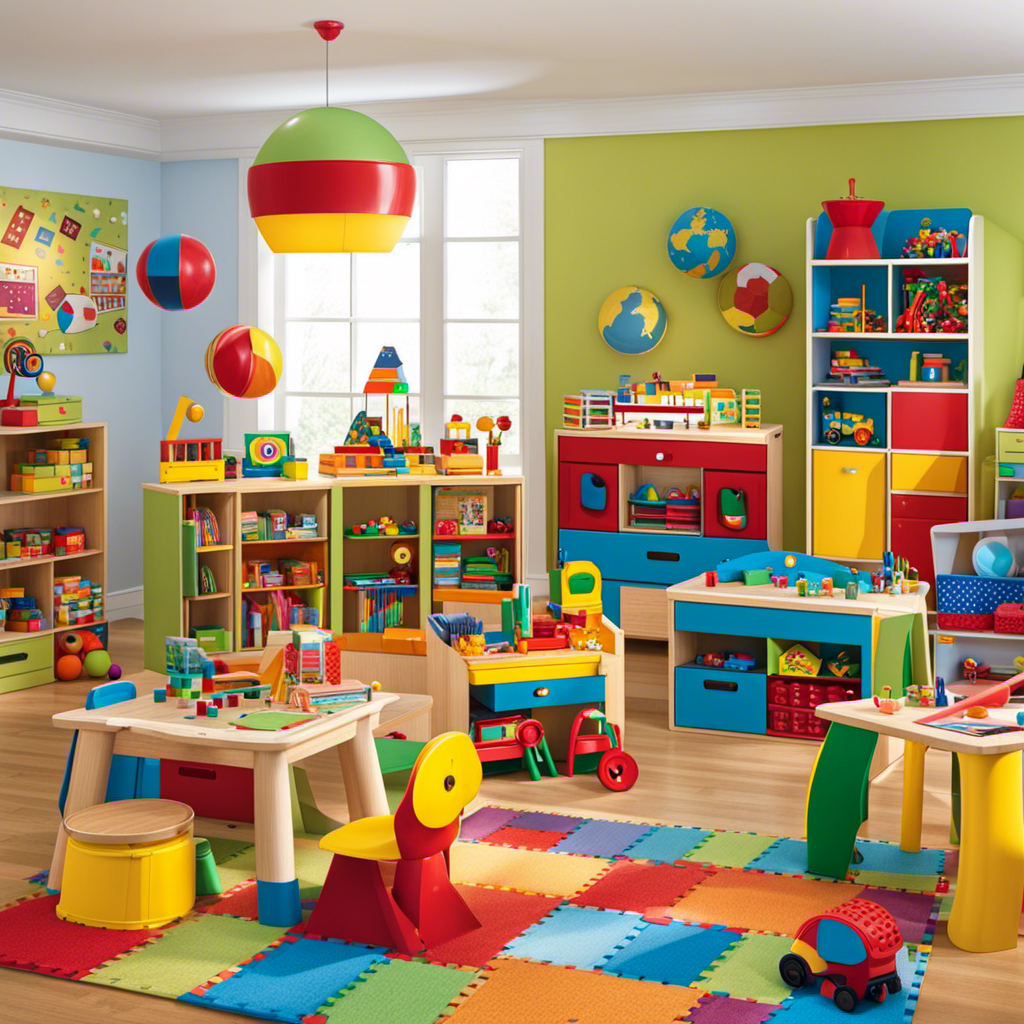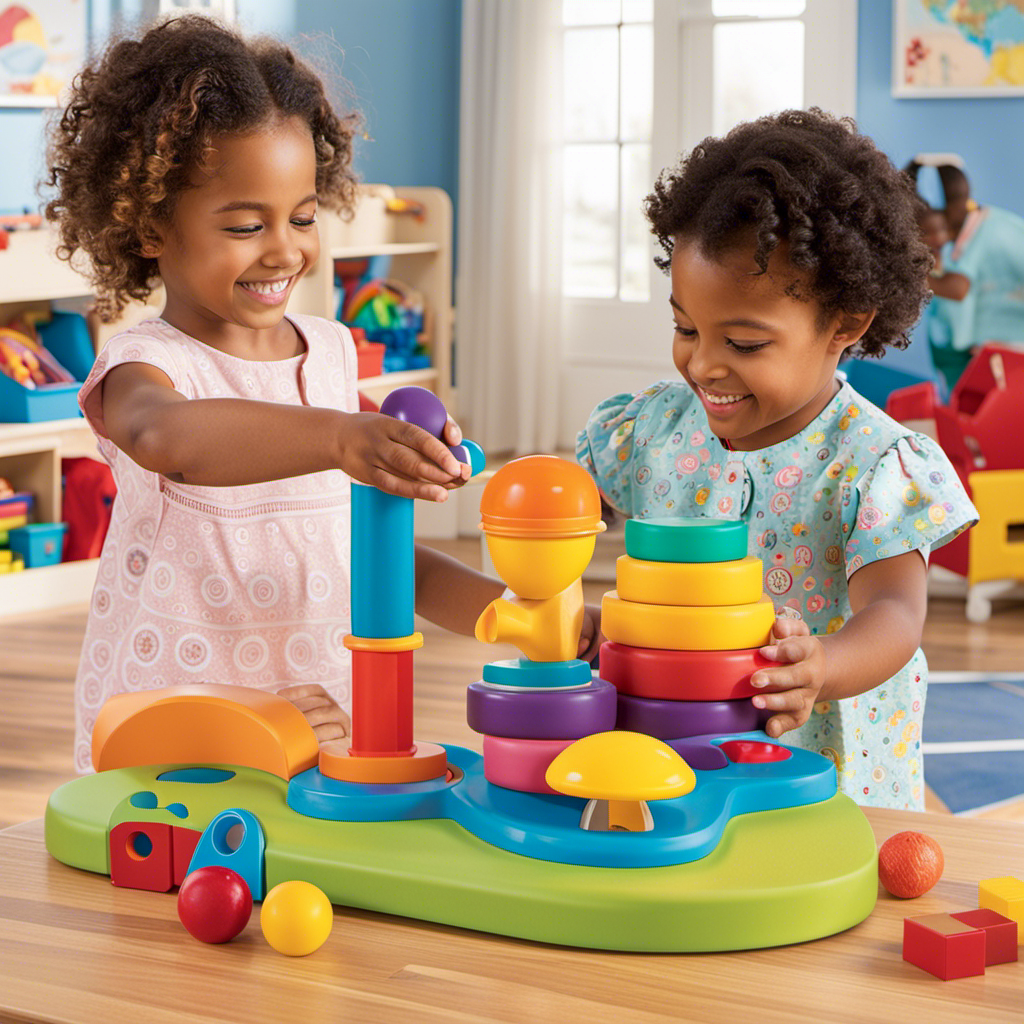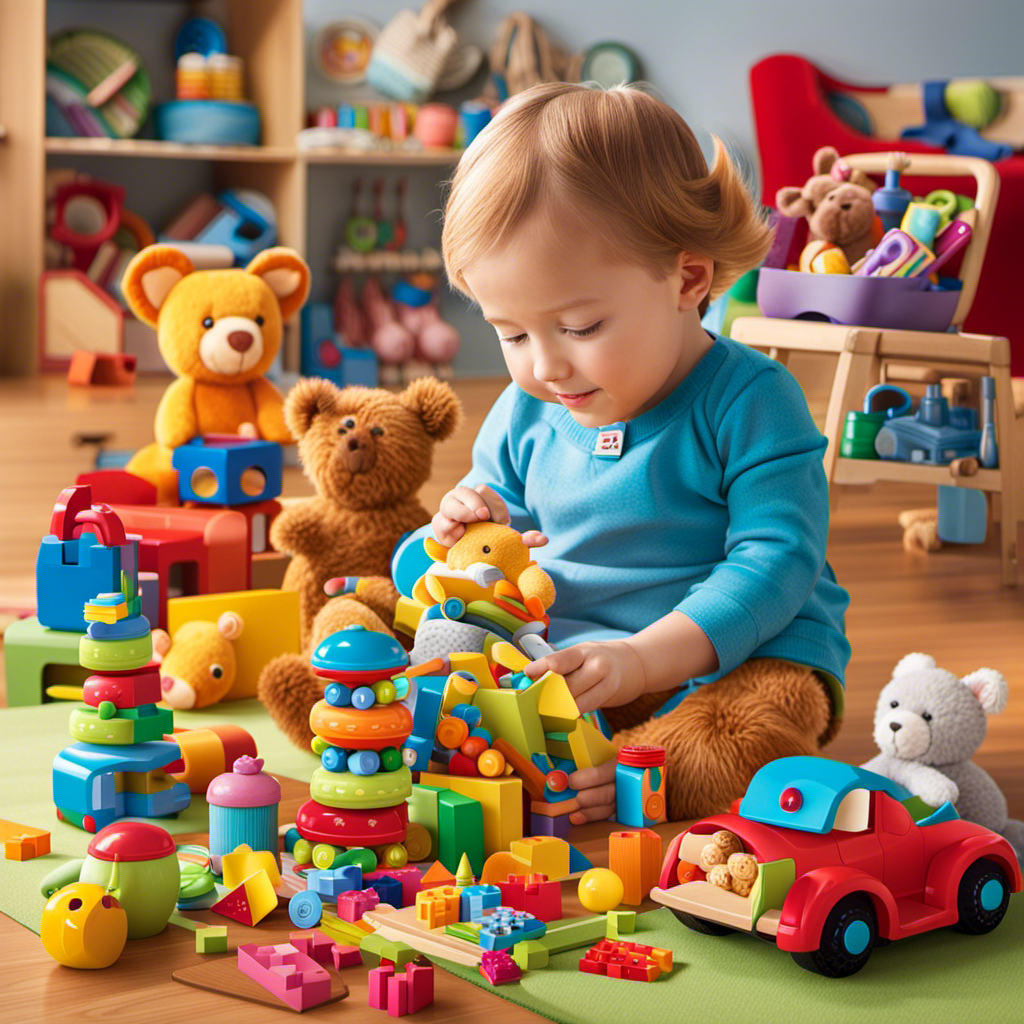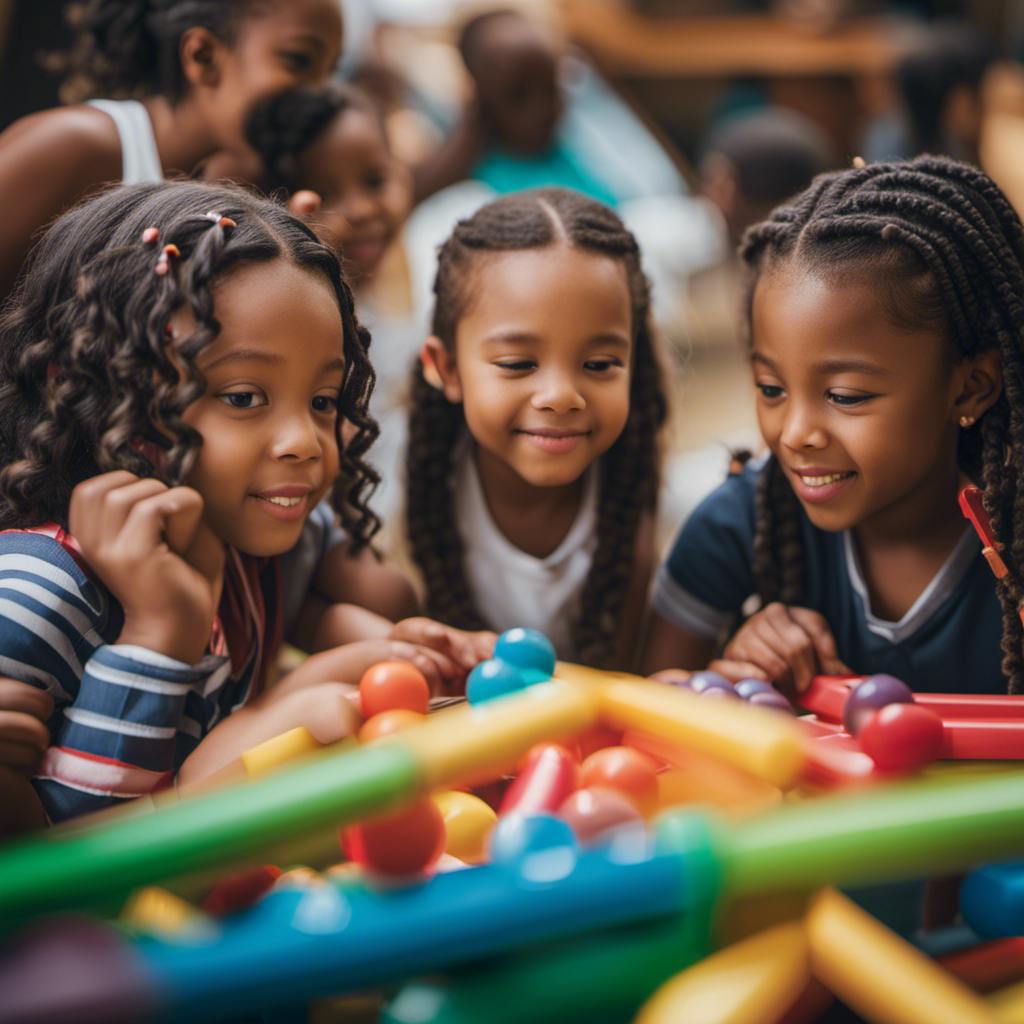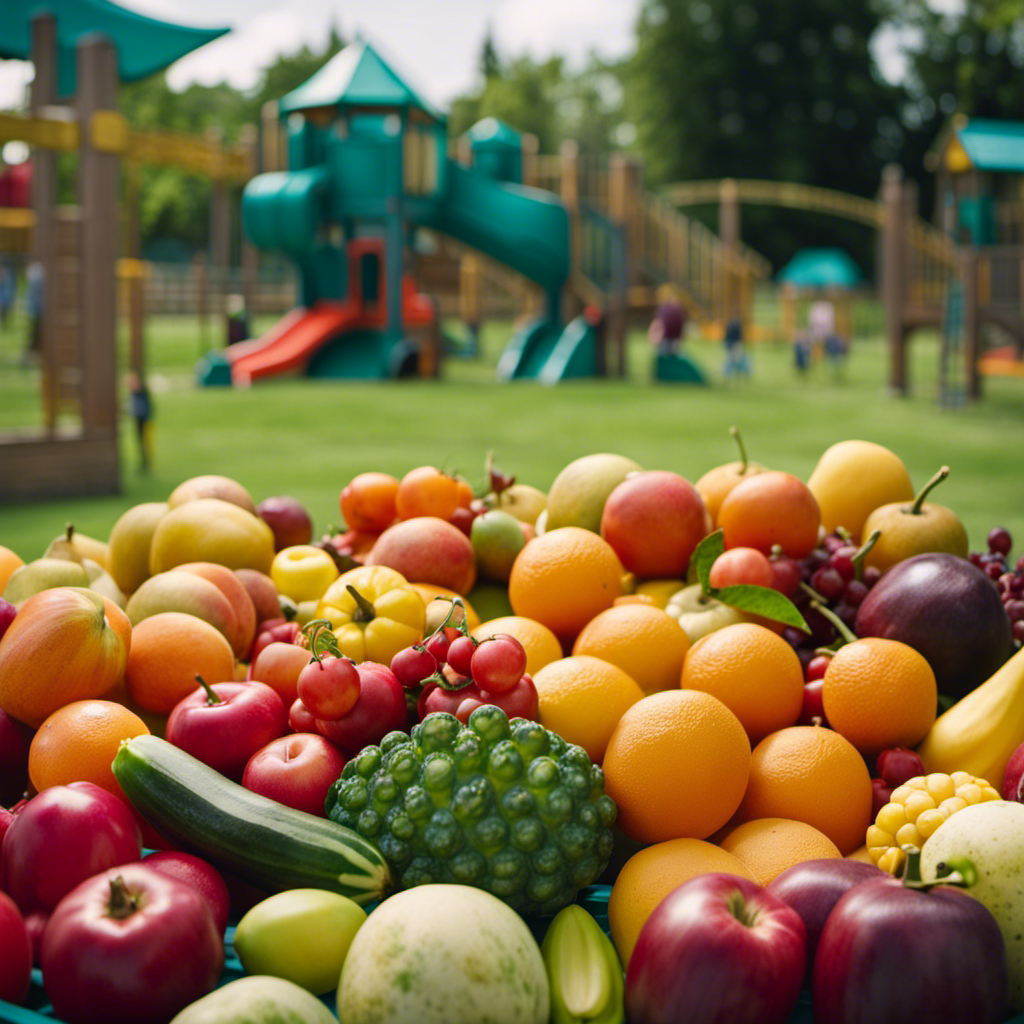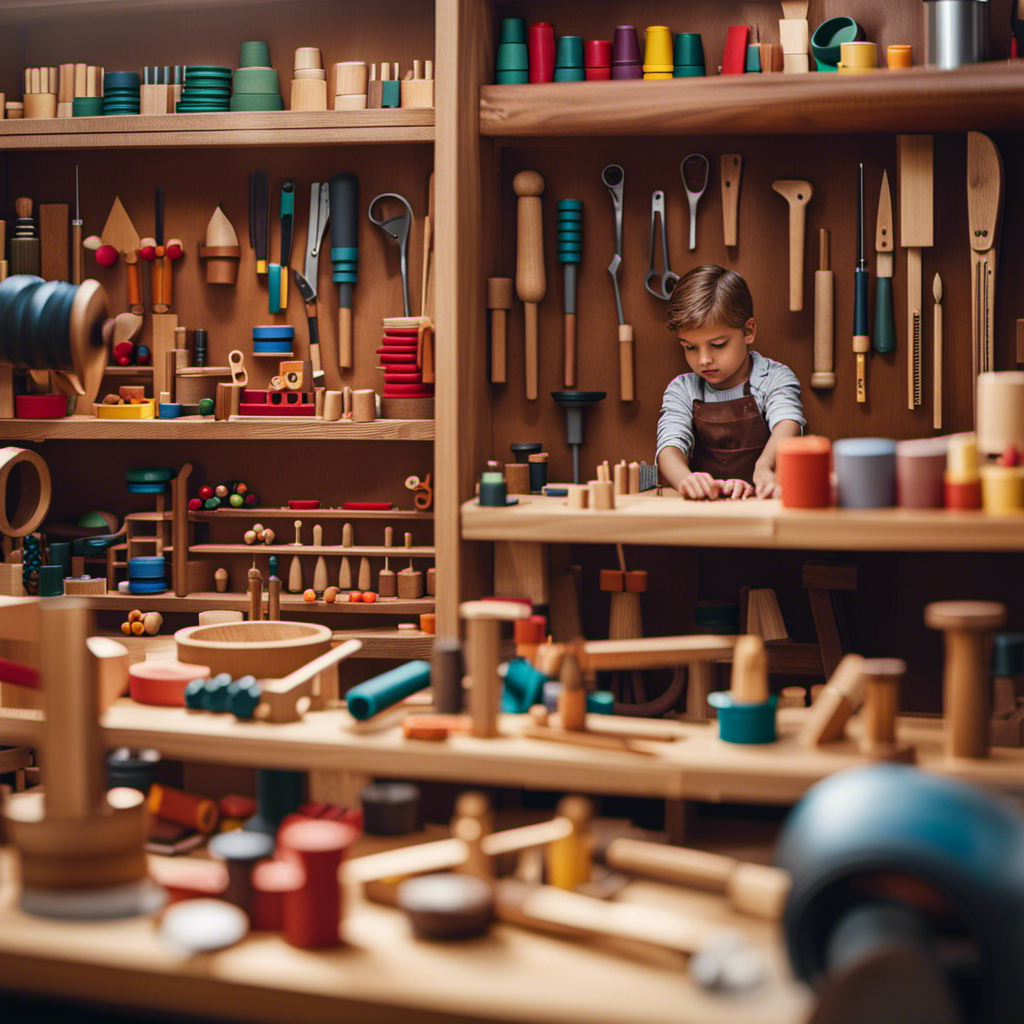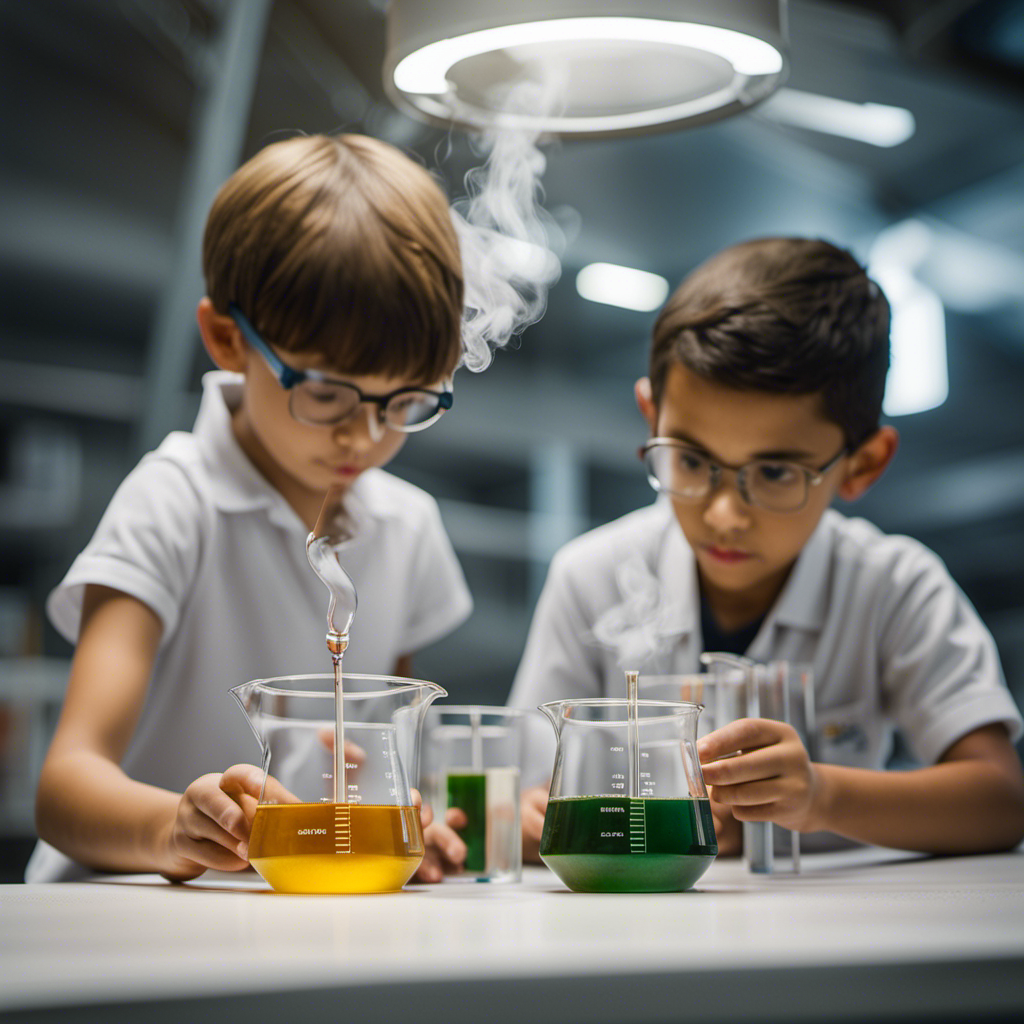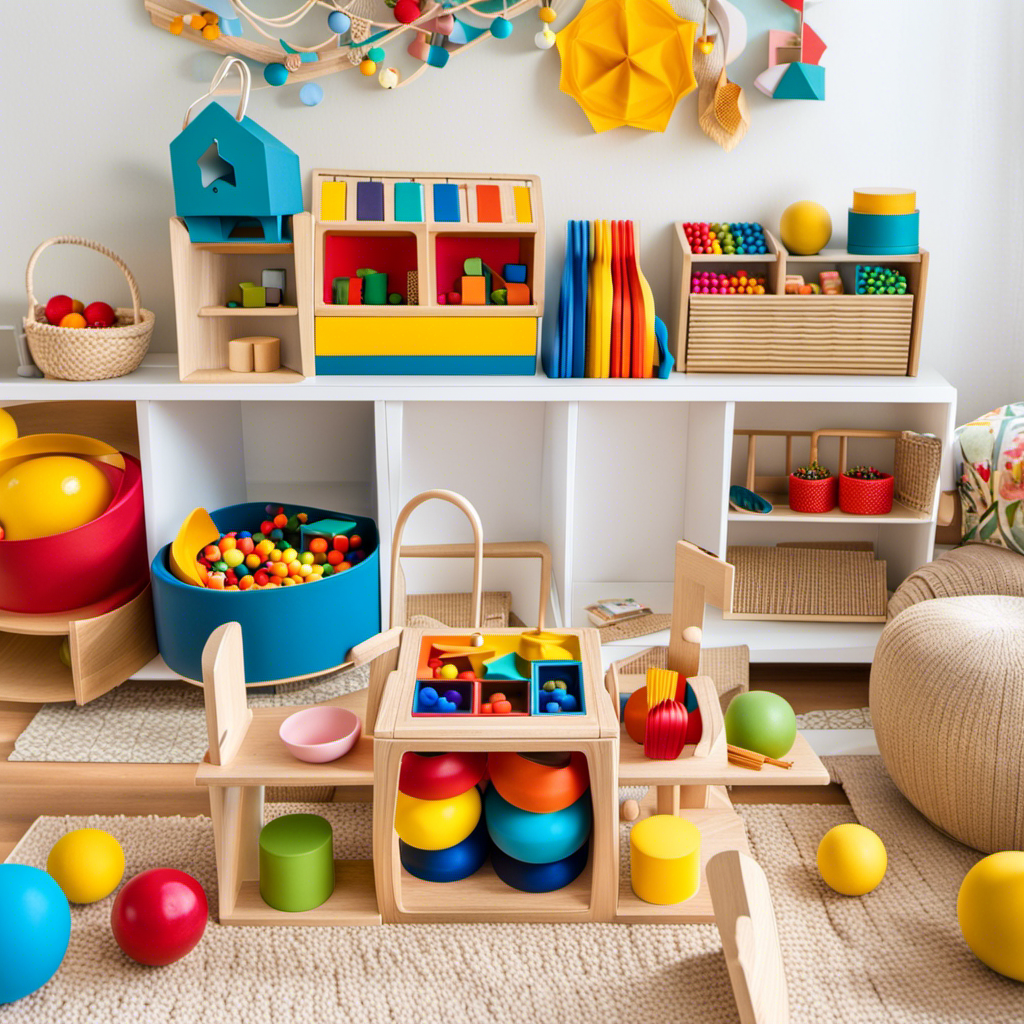Montessori Toys
The Importance of Montessori Practical Life Exercises in Child Development
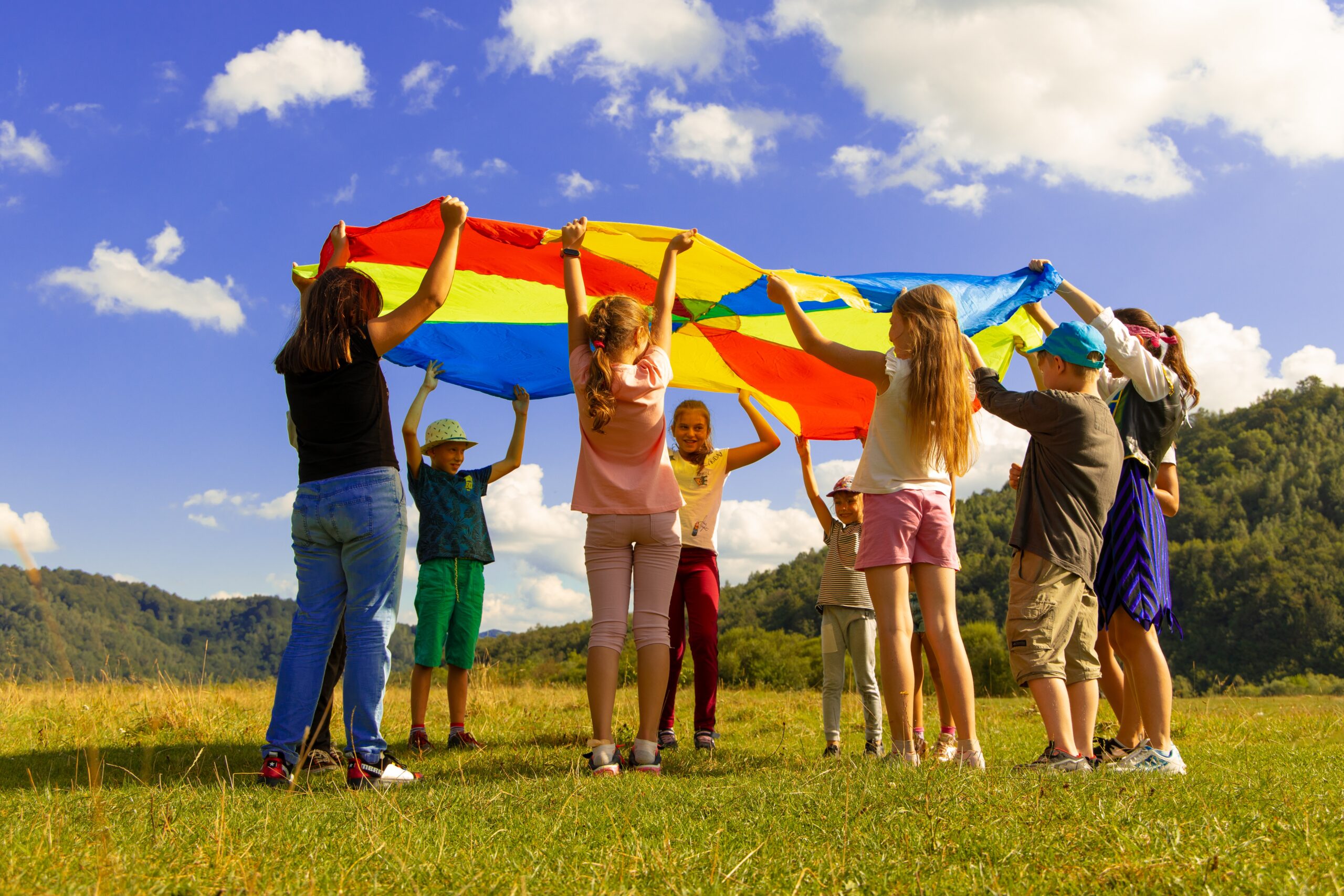
Teaching in the Montessori system has shown me how important everyday activities are for kids’ growth. Simple tasks like cooking and getting ready are more than just chores – they actually help children develop in a big way. Curious to learn more about the impact of these tasks on children’s development? Keep reading to find out!
Through these hands-on experiences, children develop fine motor skills, concentration, and problem-solving abilities. They also learn essential life skills and gain independence and confidence.
Join me as we explore the importance of Montessori practical life exercises in nurturing well-rounded and successful individuals.
Key Takeaways
- Montessori practical life exercises contribute to the development of fine motor skills, concentration, and the foundation of basic skills.
- These exercises promote independence, social skills, sensory development, and problem-solving abilities.
- By engaging in practical life activities, children become confident and normalized members of society.
- The preliminary practical life activities in Montessori classrooms focus on caring for oneself, the environment, grace and courtesy, and control of movement to foster confidence and self-esteem.
Developing Fine Motor Skills and Concentration
Developing fine motor skills and concentration is crucial in child development, as it allows me to manipulate objects with precision and focus on tasks at hand.
Montessori practical life exercises provide a perfect platform for enhancing these skills. Through activities like pouring, spooning, and buttoning, I learn to control my hand movements and develop hand-eye coordination. This helps me in activities such as writing, drawing, and using tools effectively.
Concentration is also strengthened as I engage in tasks that require my full attention. By practicing activities like transferring objects with tongs or sorting items, I learn to concentrate for extended periods of time.
These foundational skills not only prepare me for academic tasks but also contribute to my overall development and independence.
Building a Foundation of Basic Skills
I can build a strong foundation of basic skills through engaging in practical life activities. These activities not only provide me with a solid base of knowledge and skills, but they also evoke a sense of accomplishment and pride.
By participating in practical life exercises, I am able to develop important life skills that will benefit me throughout my life. These activities foster a sense of independence and self-sufficiency, allowing me to take control of my own actions and responsibilities. Additionally, they promote social skills and empathy, teaching me how to interact with others in a polite and respectful manner.
Through practical life activities, I am able to build a strong foundation of basic skills that will set me up for success in all areas of my life.
Fostering Independence and Social Skills
By engaging in practical life activities, I have witnessed firsthand how children can cultivate independence and develop valuable social skills. Through tasks such as food prep and self-grooming, they learn to take care of themselves and develop a sense of responsibility. The use of child-sized cleaning materials helps them care for their environment and develop fine motor skills. Additionally, engaging in group work and role-playing activities fosters social skills, empathy, and a sense of community. Through these activities, children learn greetings, politeness, and how to interact with others. They also learn the importance of cooperation and problem-solving through small group projects. Overall, these practical life exercises provide children with the skills and confidence they need to become independent and successful members of society.
| Benefits of Practical Life Activities | Examples of Practical Life Activities |
|---|---|
| Develop independence | Food prep and self-grooming |
| Cultivate social skills | Group work and role-playing |
| Foster responsibility | Care of the environment |
| Enhance fine motor skills | Control of movement |
| Promote problem-solving skills | Grace and courtesy |
Promoting Sensory Development and Problem-Solving
Engaging in practical life activities has allowed me to observe firsthand how children can enhance their sensory development and problem-solving skills. Through these activities, children are able to explore their senses and develop their problem-solving abilities in a hands-on and meaningful way.
Here are some ways in which practical life exercises promote sensory development and problem-solving skills:
-
Sensory exploration: Activities such as pouring, scooping, and sorting allow children to engage their senses of touch, sight, and sound, enhancing their sensory awareness and discrimination skills.
-
Sequencing and problem-solving: Activities like threading beads or completing puzzles require children to think critically and problem-solve, as they figure out the correct sequence of steps or find the right fit for each piece.
-
Cause and effect: Practical life exercises often involve cause and effect relationships, such as watering plants and observing their growth. This helps children understand the connection between their actions and the outcomes they produce.
-
Fine motor development: Many practical life activities, such as using tweezers or buttoning clothes, require precise hand movements. By practicing these activities, children develop their fine motor skills, which are essential for tasks like writing and self-care.
Overall, practical life exercises provide children with valuable opportunities to enhance their sensory development and problem-solving skills, setting a strong foundation for their future learning and development.
Helping Children Become Confident Members of Society
Teaching children practical life skills fosters their confidence and helps them become active and valued members of society. By equipping children with the necessary skills to navigate everyday life, we empower them to take charge of their own responsibilities and contribute meaningfully to their communities. Practical life exercises in Montessori classrooms are designed to instill a sense of independence and self-sufficiency in children, which in turn boosts their self-esteem. These exercises also promote valuable life skills such as problem-solving, decision-making, and responsibility. Through activities like food preparation and self-grooming, children learn the importance of taking care of themselves and develop a sense of pride in their abilities. By providing child-sized cleaning materials, we encourage children to take responsibility for their environment and develop valuable skills while having fun. Incorporating group work and role-playing activities helps children learn social skills, empathy, and cooperation, fostering a sense of community and belonging. Overall, practical life exercises play a crucial role in helping children become confident and valued members of society.
| Benefits of Practical Life Exercises | Emotional Response |
|---|---|
| Builds confidence | Empowerment |
| Fosters independence | Sense of pride |
| Develops problem-solving skills | Self-esteem |
| Promotes responsibility | Sense of accomplishment |
Preliminary Practical Life Activities in Montessori Classrooms
Incorporating a variety of activities into Montessori classrooms helps children develop important foundational skills that promote independence and confidence.
In the preliminary practical life activities, we focus on three main areas: care of self, care of the environment, and grace and courtesy.
In the care of self, we engage children in food preparation and self-grooming. This not only teaches them healthy eating habits and a love for cooking but also develops their independence, self-care skills, and confidence.
In the care of the environment, we provide child-sized cleaning materials, allowing children to contribute to the cleanliness and orderliness of their surroundings. This improves their hand-eye coordination, fine motor skills, and sense of accomplishment.
Lastly, through grace and courtesy activities, we teach social skills, empathy, and cooperation, fostering a sense of community.
Care of Self: Food Prep and Self Grooming
In Montessori classrooms, one of the preliminary practical life activities focuses on the care of self, specifically food prep and self grooming. As an educator, I believe that engaging children in these activities is crucial for their development.
Not only do they learn healthy eating habits and develop a love for cooking, but they also gain independence, self-care skills, and confidence. By incorporating practical life exercises into their daily routines, children acquire valuable life skills and a sense of responsibility. They become more self-sufficient and capable of taking care of themselves.
Moreover, these activities foster a sense of accomplishment and pride in their abilities. Teaching children to care for themselves in these ways sets a foundation for a healthy and independent lifestyle as they grow older.
Care of the Environment: Child-Sized Cleaning Materials
Using child-sized cleaning materials in the Montessori classroom allows children to improve their hand-eye coordination and fine motor skills while gaining a sense of accomplishment. When children are given the opportunity to engage in cleaning activities using tools and equipment tailored to their size, they are able to grasp and manipulate objects more easily. This not only enhances their physical development but also fosters a sense of responsibility and self-sufficiency. Children feel a sense of pride and accomplishment as they contribute to the cleanliness and orderliness of their environment. This helps them develop important skills while having fun, instilling in them a lifelong habit of taking care of their surroundings. The use of child-sized cleaning materials in the Montessori classroom is a valuable tool in promoting holistic development and instilling a sense of pride and responsibility in children.
| Benefits | Emotions |
|---|---|
| Improve hand-eye coordination and fine motor skills | Excitement |
| Grasp and manipulate objects more easily | Sense of accomplishment |
| Develop responsibility and self-sufficiency | Pride |
| Fun and enjoyable learning experience | Satisfaction |
| Instill lifelong habits of cleanliness | Sense of belonging |
Grace and Courtesy: Group Work
Moving on from the previous subtopic of ‘Care of the Environment: Child-Sized Cleaning Materials,’ we now shift our focus to the importance of ‘Grace and Courtesy: Group Work’ in Montessori practical life exercises.
This aspect of practical life activities plays a crucial role in a child’s development, fostering essential social skills, manners, and etiquette. Here are five key points to consider:
- Activities related to social skills, manners, and etiquette.
- Learning greetings, politeness, and interaction with others.
- Encouraging social skills, empathy, and a sense of community.
- Working together in small groups on projects or activities.
- Role-playing to encourage cooperation and problem-solving.
By engaging in group work, children develop the ability to cooperate, communicate effectively, and navigate social situations. These experiences lay the groundwork for building strong relationships, fostering empathy, and instilling a sense of community in children.
Through practical life exercises centered around grace and courtesy, children not only develop important social skills but also enhance their problem-solving abilities and overall emotional intelligence.
Control of Movement: Bunny Lacing Toy and Threading Trees
By engaging in activities like threading trees and using a bunny lacing toy, I develop my fine motor skills and improve my control of movement. These Montessori practical life exercises play a crucial role in my overall development.
Threading trees requires me to carefully manipulate small objects and focus on hand-eye coordination. This activity strengthens my fingers and hand muscles, enhancing my ability to perform precise movements.
Similarly, the bunny lacing toy challenges me to thread a string through various holes, refining my fine motor skills and concentration. These exercises not only help me in everyday tasks like buttoning clothes or tying shoelaces, but also improve my ability to write and draw with precision.
Through these activities, I am building a strong foundation for my future success and independence.
Overall Goal: Developing Confidence and Self-Esteem
Developing confidence and self-esteem is the ultimate goal of participating in these practical life activities. As a child engages in activities such as food prep and self-grooming, they learn valuable skills that promote independence and self-care.
Through these exercises, children develop a sense of responsibility and self-sufficiency, leading to increased confidence in their abilities.
Additionally, engaging in group work and role-playing activities related to grace and courtesy helps children build social skills, empathy, and a sense of community. By working together in small groups and practicing cooperation and problem-solving, children gain a sense of accomplishment and develop the self-esteem needed to navigate social interactions.
Overall, these practical life exercises in a Montessori classroom lay the foundation for a confident and self-assured child who is ready to take on the challenges of the world.
Engaging Children in Food Prep and Self Grooming
Engaging children in food prep and self-grooming allows me to teach them healthy eating habits and foster their love for cooking. By involving them in the process, children develop a sense of ownership over their food choices and become more willing to try new foods.
Through hands-on activities like chopping vegetables or mixing ingredients, they learn about nutrition and the importance of a balanced diet.
Additionally, being involved in self-grooming, such as washing hands or brushing teeth, helps them develop good hygiene habits and understand the importance of taking care of their bodies.
These practical life exercises not only teach valuable skills but also promote independence, confidence, and responsibility.
It’s truly rewarding to see how engaged and excited children become when they have the opportunity to be active participants in meal preparation and self-care routines.
Incorporating Practical Life Exercises Into Routine
Incorporating practical life exercises into the daily routine is a crucial aspect of Montessori education. As a teacher, I have observed the immense benefits these exercises bring to the overall development of children. By integrating practical life activities, we provide children with meaningful and purposeful tasks that contribute to their growth and independence.
In our daily routine, we incorporate activities such as setting the table for meals, watering plants, or arranging flowers. These exercises not only teach important life skills but also promote concentration, coordination, and a sense of responsibility. Children gain a sense of accomplishment and pride in completing these tasks successfully.
Furthermore, incorporating practical life exercises into the routine helps children develop a sense of order and organization. They learn to follow a sequence of steps, which enhances their problem-solving skills and attention to detail. By actively participating in these activities, children become more engaged, focused, and self-reliant.
Overall, incorporating practical life exercises into the daily routine is an essential component of Montessori education. It empowers children to become competent, independent individuals who are capable of taking care of themselves and their environment.
Care of the Environment: Child-Sized Cleaning Materials
Using child-sized cleaning materials in the classroom enhances hand-eye coordination and fine motor skills. Montessori classrooms recognize the importance of providing children with real-life tools and equipment tailored to their size. By using child-sized cleaning materials, such as brooms, mops, and dustpans, children are able to grasp and manipulate these objects more easily. This not only improves their hand-eye coordination but also develops their fine motor skills.
As children engage in cleaning activities, they learn to control their movements and carefully maneuver the cleaning tools. This fosters a sense of accomplishment and promotes a sense of responsibility towards their environment. Through the use of child-sized cleaning materials, children are able to develop important skills while having fun and gaining confidence in their abilities.
Frequently Asked Questions
How Do Montessori Practical Life Exercises Help in Developing Fine Motor Skills and Concentration?
Montessori practical life exercises greatly contribute to the development of fine motor skills and concentration. By engaging in activities such as food prep and self-grooming, children learn to control their movements and focus on specific tasks.
These exercises require precision and attention to detail, which in turn enhance their ability to concentrate. Through repetition and practice, children gradually improve their fine motor skills, enabling them to perform more complex tasks with ease.
What Are Some Examples of Basic Skills That Children Can Build Through Montessori Practical Life Activities?
Some examples of basic skills that children can build through Montessori practical life activities include food preparation, self-grooming, care of the environment, and grace and courtesy.
These activities help develop independence, fine motor skills, social skills, and problem-solving abilities. By engaging in tasks like cooking and cleaning with child-sized materials, children gain a sense of responsibility, self-sufficiency, and accomplishment.
Through group work and role-playing, they learn important social skills, empathy, and cooperation.
How Do Montessori Practical Life Exercises Foster Independence and Social Skills in Children?
Montessori practical life exercises foster independence and social skills in children by providing them with opportunities to engage in real-life activities.
Through tasks like food prep and self-grooming, children learn to take care of themselves and develop a sense of responsibility.
By using child-sized cleaning materials, they also learn to care for their environment.
Group work and role-playing activities promote social skills, empathy, and cooperation.
These exercises help children become confident, independent, and normalized members of society.
What Are Some Examples of Sensory Development Activities That Are Promoted Through Montessori Practical Life Exercises?
Some examples of sensory development activities promoted through Montessori practical life exercises include pouring and transferring activities. Children use their senses of touch and sight to manipulate and transfer materials.
They also engage in activities like sorting and matching. These activities help develop their visual discrimination skills.
Additionally, activities involving scents and textures are included. Children can smell and feel different spices or fabrics. These exercises stimulate their sense of smell and touch.
These activities provide valuable sensory experiences that enhance children’s overall development.
How Do Montessori Practical Life Exercises Help Children Become Confident Members of Society?
Montessori practical life exercises help children become confident members of society by fostering independence, social skills, and self-esteem.
Through activities like food prep and self grooming, children learn healthy habits and develop a sense of responsibility.
By using child-sized cleaning materials, they gain hand-eye coordination and a sense of accomplishment.
Group work and role-playing promote social skills, empathy, and problem-solving.
Overall, these exercises provide children with the foundation they need to become confident and normalized members of society.
Avery brings the magic of words to life at Toddler Ride On Toys. As a dedicated writer, she combines her love for writing with her fascination for child development to craft articles that resonate with our audience. With a background in journalism and a knack for storytelling, Avery’s pieces inform, engage, and inspire parents and caregivers.
Montessori Toys
The Montessori Revolution: Perfect Toy Picks for the Two-Year-Old Fashionista
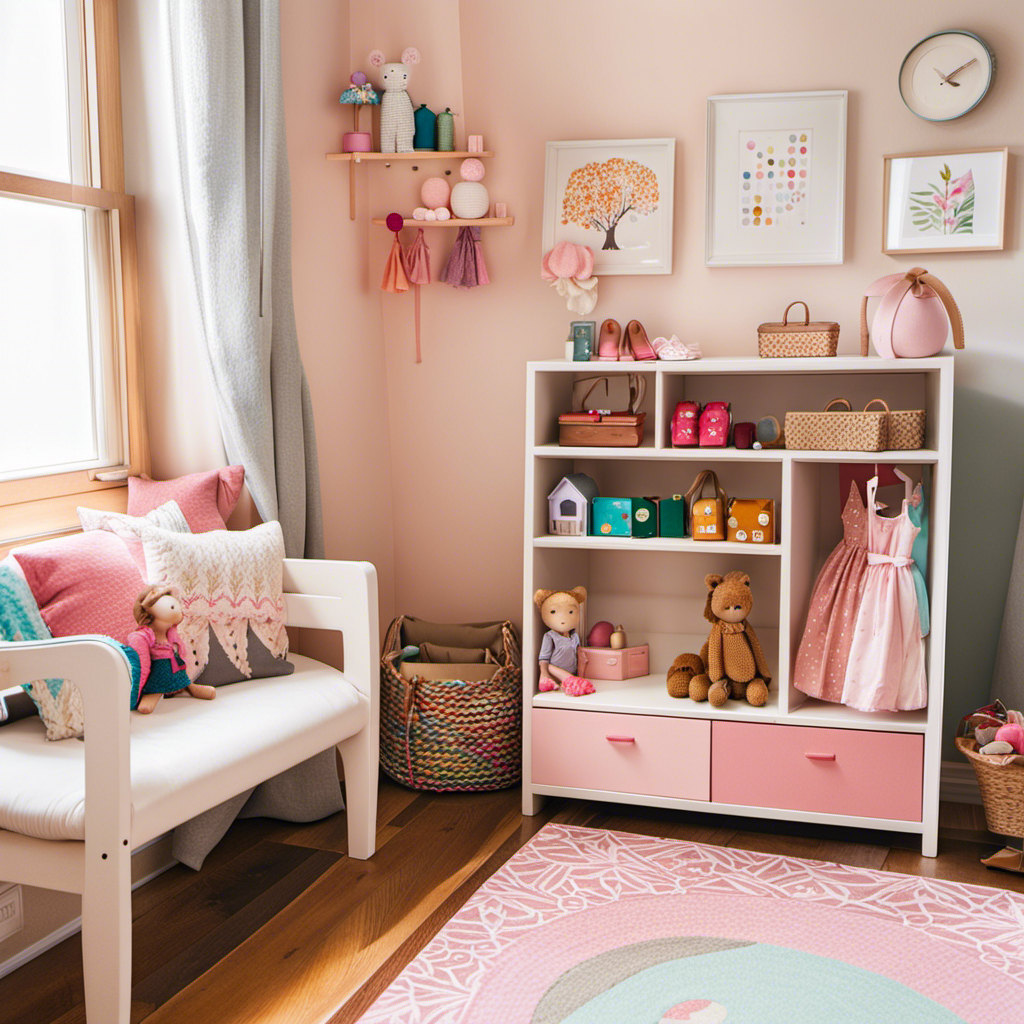
As a parent, I recognize the importance of choosing the perfect toys for our little fashion enthusiasts. That’s why I am here to introduce you to the Montessori approach to picking toys for two-year-old children.
Get ready to be amazed by the incredible selection of toys that not only engage your child’s senses but also foster their creativity and imagination. From fashionable dress-up toys to building blocks for budding designers, we’ve got it all.
So, let’s dive in and discover the world of Montessori-inspired toys that will take your child’s playtime to a whole new level.
Key Takeaways
- Montessori toys for fine motor skills and sensory development are beneficial for two-year-old fashionistas.
- Fashionable dress-up toys and age-appropriate fashion choices promote imaginative play and self-expression.
- Promoting imaginative play and independent thinking is crucial for the overall development of two-year-olds.
- Sensory play and imaginative storytelling through fashionable toys enhance cognitive development and language skills.
Montessori Toys for Developing Fine Motor Skills
You’ll love these Montessori toys for developing your two-year-old fashionista’s fine motor skills.
Montessori education emphasizes hands-on learning and encourages children to engage in activities that promote their physical and cognitive development.
When it comes to fine motor skills, fashionable art supplies and trendy sensory toys can be incredibly beneficial.
For example, providing your child with crayons, markers, and coloring books can help improve their hand-eye coordination and grip strength.
Sensory toys like playdough and building blocks allow them to explore different textures and shapes, enhancing their sensory perception and dexterity.
These toys not only stimulate their creativity but also help them develop the necessary skills for dressing up in fashionable attire.
Speaking of which, let’s now explore some fashionable dress-up toys for stylish toddlers.
Fashionable Dress-Up Toys for Stylish Toddlers
As a parent, I often find myself searching for trendy dress-up options that are not only age-appropriate but also promote imaginative play.
It can be challenging to find fashion choices that allow my toddler to express their personal style while still being safe and suitable for their age.
In this discussion, I will explore different dress-up toys and clothing options that are both fashionable and developmentally appropriate for stylish toddlers.
Trendy Dress-Up Options
Get your little fashionista ready for the runway with these trendy dress-up options.
Dress-up play is a wonderful way for toddlers to explore their creativity and imagination while developing important cognitive and social skills.
When it comes to age-appropriate dress-up options, it’s important to choose items that are safe and suitable for your child’s age group. Look for dress-up clothes that are easy to put on and take off, such as velcro or snap closures.
Trendy fashion accessories like hats, scarves, and sunglasses can add the perfect finishing touch to any outfit. By providing your child with a variety of dress-up options, you’re encouraging their self-expression and fostering their love for fashion.
Now, let’s move on to discussing age-appropriate fashion choices for your little fashionista.
Age-Appropriate Fashion Choices
When choosing age-appropriate fashion for your little one, it’s important to consider their comfort and style preferences. Here are some trendy and practical fashion choices for your fashionista-in-training:
-
Soft and Stretchy Fabrics: Opt for clothes made from soft and breathable materials like cotton or bamboo. These fabrics will keep your child comfortable and allow for easy movement.
-
Fun Prints and Patterns: Let your little one express their personality through their clothes by choosing outfits with playful prints and patterns. From cute animals to colorful shapes, these designs will add a touch of whimsy to their wardrobe.
-
Fashion Forward Footwear: Look for shoes that are not only stylish but also provide proper support for growing feet. Sneakers with cushioning and adjustable straps are a great choice for active toddlers.
-
Versatile Layering Pieces: Invest in versatile pieces like cardigans, hoodies, and leggings that can be layered to create different looks. This allows for easy transitioning between seasons and provides flexibility for changing weather conditions.
By selecting age-appropriate fashion trends and fashion forward footwear, you can help your little one develop their personal style while ensuring their comfort and safety.
Now let’s explore how promoting imaginative play can further enhance their development.
Promoting Imaginative Play
Encouraging imaginative play allows children to explore their creativity and develop important problem-solving skills. Pretend play is a fundamental aspect of a child’s development, providing them with the opportunity to use their imagination and engage in imaginative storytelling. Through pretend play, children are able to take on different roles, create narratives, and solve problems in a safe and imaginative environment.
Research has shown that pretend play has numerous benefits for children. It helps them develop their language skills, as they engage in conversations and storytelling. It also enhances their cognitive abilities, as they learn to think critically and solve problems within the context of their imaginative play scenarios.
By providing children with toys and materials that encourage pretend play, such as dress-up clothes, dolls, and play kitchens, we are fostering their creativity and supporting their overall development. These toys allow children to create their own narratives, explore different social situations, and develop important skills for their future.
Transitioning into the subsequent section about sensory play: engaging the senses with fashionable toys, we can see how these types of toys can further enhance a child’s play experience.
Sensory Play: Engaging the Senses With Fashionable Toys
Fashionable toys provide a sensory experience for the two-year-old fashionista. These toys not only engage their sense of touch but also stimulate their imagination and creativity.
Here are some sensory toys for stylish toddlers that can enhance their playtime:
- Soft fabric dolls with different textures and patterns to explore.
- Musical instruments like mini keyboards or xylophones to introduce them to different sounds and rhythms.
- Fashion-themed sensory bins filled with colorful beads, buttons, and fabrics for them to touch and sort.
- Dress-up sets with various textures and fastenings to help develop their fine motor skills.
- Scented playdough or scented markers to engage their sense of smell.
By encouraging fashionable sensory play, we can provide a well-rounded sensory experience for our little fashionistas.
Transitioning into the next section about Montessori-friendly toys, we can continue to foster their creativity and imagination through carefully selected toys and activities.
Montessori-Friendly Toys to Foster Creativity and Imagination
When it comes to fostering creativity and imagination in children, open-ended play options are essential.
These types of toys and activities allow children to explore, experiment, and create on their own terms, promoting independent thinking and problem-solving skills.
Through open-ended play, children are also able to engage in imaginative storytelling, creating their own narratives and developing their language and communication skills.
Open-Ended Play Options
There’s no limit to the possibilities with open-ended play options for your two-year-old fashionista. These types of toys allow children to explore their creativity and imagination in various ways.
When it comes to fashionable sensory toys, there are plenty of options to choose from. Sensory play is not only fun, but it also helps in the development of fine motor skills and sensory processing. Toys like dress-up sets, soft fabric dolls, and textured bracelets can engage your child’s senses while promoting imaginative play.
These toys encourage children to use their imagination and create their own stories, allowing them to express themselves freely. By offering open-ended play options, you are giving your child the opportunity to think independently and make choices based on their own preferences and interests.
This promotes their cognitive and problem-solving skills, setting the foundation for a lifelong love of learning.
Promoting Independent Thinking
You can encourage your child to think independently by providing them with open-ended play options that promote creativity and imagination. Open-ended play allows children to explore and problem solve on their own, developing critical thinking and decision-making skills.
When children engage in activities that have no predetermined outcome, they are forced to think for themselves and make choices based on their own interests and preferences. This kind of play empowers children to trust their own judgment and develop confidence in their ability to make decisions.
As they grow, these critical thinking and decision-making skills will become invaluable assets in their lives. And as they continue to explore and create, they will naturally transition into the next section about inspiring imaginative storytelling, where they can use their newfound skills to create their own narratives and bring their stories to life.
Inspiring Imaginative Storytelling
Encouraging open-ended play allows children to tap into their creativity and imagination, inspiring them to tell imaginative stories. One way to inspire creative storytelling is through imaginative play with animals. By providing children with animal figurines, they can create their own stories and scenarios, using their imagination to bring these characters to life.
Whether it’s a jungle adventure with lions and monkeys or a farmyard scene with cows and pigs, children can let their creativity soar as they weave together exciting tales. This type of play not only enhances their storytelling abilities but also helps develop their language skills, problem-solving abilities, and social interactions. Imaginative play with animals provides a platform for children to explore different roles, emotions, and storylines, enhancing their overall cognitive development.
Now, let’s move on to explore the building blocks for fashionistas: toy sets for construction and design.
Building Blocks for Fashionistas: Toy Sets for Construction and Design
If your two-year-old is a fashionista, they’ll love playing with these toy sets for construction and design. These innovative fashion toys are not only fun but also provide creative inspiration for budding designers. Here are five toy sets that are perfect for imaginative play and encourage your child’s love for fashion:
-
LEGO Friends Heartlake City Resort: This set allows your child to build their own resort complete with a fashion boutique and runway.
-
Melissa & Doug Design-Your-Own Bracelets: With this set, your little fashionista can create their own unique bracelets using colorful beads and charms.
-
Barbie Fashion Design Maker: This toy set lets your child design and print their own fashion creations using a computer program and fabric sheets.
-
Magnetic Dress-Up Dolls: These sets come with magnetic clothing pieces and dolls, allowing your child to mix and match outfits for endless fashion fun.
-
Fashion Plates Deluxe Kit: With this set, your child can create stylish outfits by mixing and matching different plates and using colored pencils to add their own designs.
These toy sets provide a perfect balance of creative construction and design, inspiring fashion ideas while engaging in imaginative play.
Transitioning into the next section, let’s explore fashion dolls and accessories for even more role-playing fun.
Fashion Dolls and Accessories for Role-Playing Fun
After exploring building blocks for fashionistas, let’s dive into the world of fashion dolls and accessories for role-playing fun. As a parent, it’s important to provide toys that encourage imaginative play and creativity.
Fashionable dollhouses and fashion-themed board games are great options for your two-year-old fashionista.
In a dollhouse, your child can create their own stylish world, decorating rooms and arranging furniture. This fosters their creativity and helps them develop fine motor skills.
Fashion-themed board games, on the other hand, allow your little one to dress up dolls, design outfits, and even participate in fashion shows. These games promote problem-solving skills, decision-making, and social interaction.
Incorporating these fashion-themed toys into your child’s playtime routine will not only provide endless hours of entertainment but also help them develop important cognitive and social skills.
But don’t worry, we’re not done yet! Next, we’ll explore Montessori-inspired toys for developing cognitive skills.
Montessori-Inspired Toys for Developing Cognitive Skills
When it comes to choosing toys for my child, I always prioritize ones that can enhance their problem-solving abilities, promote independent thinking, and foster logical reasoning skills.
Research has shown that engaging in activities that require problem-solving can help children develop critical thinking skills and improve their decision-making abilities.
By encouraging independent thinking, children can learn to think for themselves, make their own choices, and develop their creativity.
Additionally, fostering logical reasoning skills can help children make sense of the world around them and make more informed decisions in various situations.
Enhancing Problem-Solving Abilities
Enhancing problem-solving abilities can be achieved through interactive toys that engage a two-year-old fashionista’s curiosity. Problem solving through creative play and hands-on activities is crucial for the cognitive development of young children. By providing them with toys that encourage problem-solving, we are fostering their critical thinking skills and preparing them for future challenges.
One effective way to enhance problem-solving abilities is through puzzles. These toys not only engage a child’s curiosity but also require them to think logically and find solutions. Another great option is building blocks, which promote problem-solving through spatial reasoning and engineering skills. Lastly, shape sorting toys help children recognize patterns and develop problem-solving strategies.
Promoting Independent Thinking
To promote independent thinking, you can encourage your child to explore new ideas and make decisions on their own. One effective way to do this is by providing them with toys that develop critical thinking skills and promote independent decision making.
Toys such as building blocks, puzzles, and problem-solving games can help your child develop their problem-solving abilities, logical reasoning skills, and creativity. These toys encourage children to think critically, analyze situations, and come up with their own solutions.
By allowing your child to play with these types of toys, you are giving them the opportunity to think independently and make decisions based on their own observations and judgments. This will not only enhance their cognitive abilities but also foster their self-confidence and independence.
Transitioning into fostering logical reasoning skills, it is important to provide your child with toys that challenge their thinking and require them to use logical reasoning to solve problems.
Fostering Logical Reasoning Skills
One way to foster logical reasoning skills is by providing toys that challenge your child’s thinking and require them to use logical reasoning to solve problems. Here are three examples of toys that can help develop critical thinking and logical reasoning in young children:
-
Puzzle sets: These sets come with various shapes and colors that children need to fit together to create a complete picture. This encourages them to think logically and problem-solve as they figure out how the pieces fit together.
-
Building blocks: Building blocks allow children to experiment with different combinations and structures. They learn cause and effect as they try different arrangements and discover what works and what doesn’t.
-
Sorting games: Sorting games involve categorizing objects based on specific attributes such as color, shape, or size. This helps children develop their logical reasoning skills by understanding patterns and making connections.
By providing these types of toys, you can help your child develop critical thinking and logical reasoning abilities from a young age.
Now, let’s explore some stylish puzzles and games for our two-year-old fashionistas.
Stylish Puzzles and Games for Two-Year-Old Fashionistas
Looking for stylish puzzles and games for your two-year-old fashionista? Look no further! Engaging your child in play that combines their love for fashion with critical thinking skills can be both fun and educational.
Stylish puzzles are a great way to foster logical reasoning while encouraging creativity in their fashion choices. These puzzles often feature images of fashionable clothing items, accessories, and even fashion shows, allowing your little one to explore different styles and patterns as they piece together the puzzle.
By engaging in these activities, your child will develop their problem-solving abilities while also honing their eye for detail and design.
Transitioning into the next section about musical toys for the budding fashionista, let’s explore how music can further enhance their creative expression and fashion sense.
Musical Toys for the Budding Fashionista
Are you ready to explore how musical toys can enhance your budding fashionista’s creative expression and fashion sense?
Musical fashion accessories and fashion-inspired instrument toys are not only entertaining but also provide numerous benefits for your child’s development. Here are three reasons why these toys are perfect for your little fashionista:
-
Self-expression: Musical toys allow your child to express themselves through sound and rhythm, fostering their creativity and artistic abilities.
-
Sensory development: Playing with musical toys helps develop your child’s sensory skills, as they engage with different sounds, textures, and movements.
-
Fashion sense: Musical fashion accessories, such as jewelry with built-in musical instruments, can spark your child’s interest in fashion and encourage them to experiment with their style.
By incorporating musical toys into your child’s playtime, you are not only promoting their creativity but also nurturing their fashion sense.
Now, let’s move on to the next section about outdoor play: fashionable toys for active toddlers.
Outdoor Play: Fashionable Toys for Active Toddlers
Get ready to discover fashionable toys that will keep your active toddler entertained and stylish during outdoor playtime.
When it comes to outdoor fashion, there are plenty of options for your little fashionista. Look for toys that not only provide fun and entertainment but also add a touch of style to their playtime.
From trendy tricycles to chic scooters, there are stylish play equipment options available for every toddler. Opt for bright colors, sleek designs, and fun patterns to keep your child engaged and fashionable.
Don’t forget about accessories like sunglasses, hats, and backpacks that can elevate their outdoor look.
With the right toys and accessories, your active toddler can enjoy outdoor play while staying stylish and fashionable.
Frequently Asked Questions
Are Montessori Toys Only Beneficial for Developing Fine Motor Skills or Do They Offer Other Developmental Benefits as Well?
Montessori toys are not only beneficial for developing fine motor skills but also have a significant impact on language development and social-emotional skills. Research shows that these toys promote communication, problem-solving, and empathy in young children.
Can Fashionable Dress-Up Toys Help Toddlers Develop Their Creativity and Imagination?
Yes, fashionable dress-up toys can help toddlers develop their creativity and imagination. Research shows that engaging in pretend play with different outfits and accessories allows them to explore their imagination and express themselves creatively.
How Do Sensory Play Toys Engage the Senses and Contribute to a Child’s Overall Development?
Sensory play toys engage the senses and contribute to a child’s overall development. Research shows that these toys enhance cognitive, social, and emotional skills. They come in various types, such as texture blocks and musical instruments, providing a well-rounded sensory experience.
Are Montessori-Friendly Toys Suitable for Children With Cognitive Challenges or Special Needs?
Montessori-friendly toys can be adapted for children with cognitive challenges or special needs. By understanding their sensory sensitivities, we can incorporate Montessori principles to create a supportive and engaging environment for their development.
Can Playing With Building Blocks and Toy Sets for Construction and Design Enhance a Child’s Problem-Solving and Critical Thinking Skills?
Playing with building blocks and toy sets can greatly enhance a child’s problem-solving and critical thinking skills. The hands-on experience of constructing and designing fosters creativity and encourages logical thinking in a fun and engaging way.
Conclusion
In conclusion, the Montessori approach to toy selection for two-year-old fashionistas is not only practical but also research-based. By providing toys that develop fine motor skills, foster creativity, engage the senses, and stimulate cognitive skills, parents can support their child’s development while nurturing their fashion sense.
From dress-up toys to building blocks and musical instruments, there are plenty of options to choose from. So, let’s embark on this Montessori revolution and watch our little fashionistas thrive and flourish in style.
After all, as Albert Einstein once said, "Creativity is intelligence having fun."
Tina is the heart and soul behind Toddler Ride On Toys. With a passion for early childhood education and a deep understanding of child development, Tina ensures that every piece of content on our website reflects our commitment to playful learning. Her expertise in Montessori, Preschool, STEM, and Waldorf education philosophies helps shape our website into a valuable resource for parents, caregivers, and educators.
Montessori Toys
From Walking to Talking: Montessori Toys That Fuel Two-Year-Olds’ Adventures
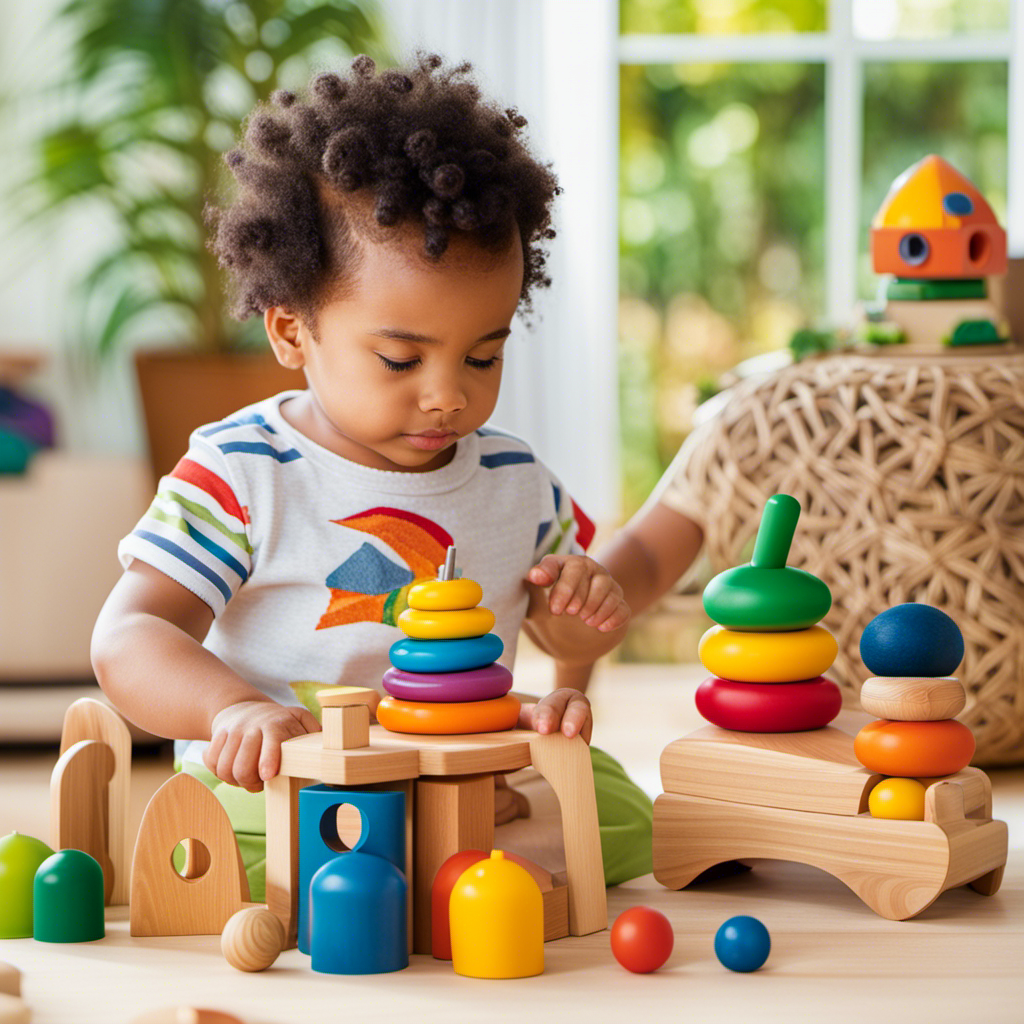
As a parent of a two-year-old, I understand the importance of choosing toys that not only entertain but also promote their development. Did you know that Montessori toys are recognized for helping children progress from their first steps to their first words?
In this article, we will explore the various ways in which Montessori toys can enhance fine motor skills, language development, cognitive abilities, independence, social skills, sensory play, and problem-solving skills in two-year-olds.
So let’s dive in and discover the perfect Montessori toys for your little one’s exciting journey of growth and exploration.
Key Takeaways
- Montessori toys stimulate creativity and imaginative play
- Engaging with Montessori toys enhances cognitive development and problem-solving skills
- Montessori toys offer endless possibilities for self-expression and creativity
- Montessori toys promote hand-eye coordination, creativity, and imagination
The Importance of Montessori Toys for Two-Year-Olds
The Importance of Montessori Toys for Two-Year-Olds can’t be emphasized enough. These toys play a crucial role in stimulating creativity and promoting imaginative play in young children. Research has shown that engaging with Montessori toys at this age helps to foster a child’s cognitive development and enhances their problem-solving skills.
By providing open-ended and hands-on learning experiences, these toys encourage children to think outside the box, explore their surroundings, and use their imagination to create and discover new things. Montessori toys, such as building blocks, puzzles, and pretend play sets, offer endless possibilities for children to express themselves and develop their creativity.
As we transition into the next section about stimulating fine motor skills with Montessori toys, it is important to note that these toys also support overall development in children beyond just imaginative play.
Stimulating Fine Motor Skills With Montessori Toys
Enhance your child’s fine motor skills with these Montessori toys. Montessori toys are designed to promote the development of hand-eye coordination, creativity, and imagination in children. Through interactive play, these toys provide opportunities for children to refine their fine motor skills while engaging their minds.
Here are four examples of Montessori toys that can help with this development:
-
Building Blocks: Manipulating and stacking blocks not only strengthens hand muscles but also enhances spatial awareness and problem-solving skills.
-
Puzzles: Assembling puzzles requires precise hand movements, improving hand-eye coordination and cognitive skills.
-
Bead Maze: Moving beads along a wire maze helps children practice their pincer grasp and hand-eye coordination.
-
Art Supplies: Drawing, painting, and sculpting with child-safe art materials encourage creativity and fine motor skill development.
Encouraging Language Development Through Montessori Toys
Encouraging language development can be achieved through the use of Montessori toys that incorporate interactive storytelling and engaging activities.
These toys not only provide entertainment but also stimulate vocabulary growth and build communication skills in two-year-olds. Research has shown that interactive storytelling helps children develop language skills by exposing them to new words, sentence structures, and storytelling techniques.
Through these toys, children can actively participate in the stories, using their imagination and creativity to express themselves. Additionally, engaging activities such as matching games, puzzles, and sorting activities promote language development by encouraging children to communicate and describe their actions.
By incorporating these language-focused Montessori toys into a child’s playtime, parents and caregivers can help enhance their language skills and prepare them for successful communication in the future.
Transitioning into the next section, Montessori toys also play a crucial role in enhancing cognitive abilities.
Enhancing Cognitive Abilities With Montessori Toys
As a parent, I’ve always been fascinated by the benefits of Montessori toys and how they can enhance my child’s cognitive development.
Through play, children can develop important skills such as problem-solving, critical thinking, and creativity.
However, it’s crucial to choose the right toys that align with Montessori principles and promote hands-on learning experiences for optimal cognitive growth.
Montessori Toy Benefits
You’ll love the benefits of Montessori toys for your two-year-old’s development.
Play is an essential part of a child’s learning process, and Montessori toys are specifically designed to promote learning through play. These toys encourage hands-on exploration and problem-solving, allowing children to develop critical thinking skills while having fun.
Montessori toys are carefully crafted to engage children’s senses, promoting sensory development and fine motor skills. Through play, children also learn important social and emotional skills, such as sharing, taking turns, and empathy.
Cognitive development is enhanced as children engage in imaginative play, building their creativity and language skills. As children explore and interact with Montessori toys, they develop a deeper understanding of the world around them.
Transitioning into the next section, let’s explore how cognitive development can be further nurtured through play.
Cognitive Development Through Play
Playing with age-appropriate toys can greatly contribute to the cognitive development of young children. Research shows that engaging in play helps children develop important skills and abilities that are crucial for their overall growth. Here are some ways in which playing with toys promotes creativity and develops problem-solving skills:
-
Encourages imagination and creativity: Toys that allow children to pretend play or build their own creations stimulate their imagination and foster creativity. Art supplies and open-ended toys like blocks or puzzles provide opportunities for self-expression and problem-solving.
-
Enhances problem-solving skills: Toys that require children to figure out how things work or solve puzzles enhance their problem-solving abilities. Building toys and games that involve logical thinking and strategy help children develop critical thinking skills.
By providing children with age-appropriate toys that promote creativity and develop problem-solving skills, we can support their cognitive development and prepare them for future challenges.
Now, let’s explore how to choose the right toys for two-year-olds.
Choosing the Right Toys
When selecting toys for your two-year-old, it’s important to consider their developmental stage and interests. Toys for imaginative play can greatly benefit their cognitive and social development. Open-ended toys, in particular, provide endless possibilities for creativity and problem-solving. They encourage children to think critically, experiment, and explore their surroundings.
Here is a table showcasing some examples of open-ended toys that promote imaginative play:
| Toy Type | Examples | Benefits |
|---|---|---|
| Building Blocks | Lego Duplo, Wooden Blocks | Enhances fine motor skills, spatial awareness, and creativity |
| Pretend Play | Play Kitchen, Doctor Kit | Develops social and communication skills, sparks imagination |
| Art Supplies | Crayons, Play-Doh, Finger Paints | Stimulates sensory exploration, encourages self-expression |
| Dress-Up | Costumes, Hats, Accessories | Fosters creativity, role-playing, and storytelling |
| Puzzles | Chunky puzzles, Jigsaw puzzles | Improves problem-solving, hand-eye coordination, and patience |
Fostering Independence With Montessori Toys
Encourage independence with Montessori toys that allow toddlers to explore and learn at their own pace.
Montessori toys are designed to foster creativity and promote self-confidence in young children. These toys are carefully crafted to engage children in hands-on activities that stimulate their imagination and problem-solving skills.
By providing open-ended materials such as building blocks, puzzles, and art supplies, Montessori toys empower toddlers to make choices and take control of their learning. This sense of autonomy helps build their self-esteem and encourages them to think independently.
As they explore these toys, toddlers develop their fine motor skills, hand-eye coordination, and cognitive abilities. By nurturing their independence, Montessori toys lay a strong foundation for lifelong learning.
Transitioning into the next section about promoting social skills through Montessori toys, we can see how these toys facilitate collaboration and communication among children.
Promoting Social Skills Through Montessori Toys
By engaging with other children through collaborative play, toddlers can develop important social skills while using Montessori toys. Social interaction is a crucial aspect of a child’s development, as it helps them learn how to communicate, negotiate, and empathize with others. Montessori toys provide an excellent platform for fostering these skills in a fun and interactive way.
Here are three ways Montessori toys promote social skills and emotional intelligence:
- Turn-taking: Playing with Montessori toys encourages toddlers to take turns, teaching them patience and the importance of sharing.
- Cooperation: Collaborative play with Montessori toys requires children to work together towards a common goal, fostering teamwork and cooperation.
- Empathy: Montessori toys often involve role-playing or storytelling, allowing children to explore different perspectives and develop empathy towards others.
Through these social interactions, toddlers not only enhance their social skills but also cultivate emotional intelligence. As they learn to navigate relationships and understand others’ feelings, they are better equipped to navigate the world around them. This lays a solid foundation for their future social development.
Transition: Now that we’ve explored the importance of social skills, let’s delve into the world of sensory play with Montessori toys.
Exploring Sensory Play With Montessori Toys
Get ready to dive into the world of sensory play with Montessori toys. Here, you can explore different textures, colors, and sounds to stimulate your senses and enhance your learning experience.
Sensory exploration is a crucial aspect of a child’s development. It allows them to engage with their environment and make sense of the world around them. Montessori toys are designed to provide tactile stimulation, encouraging children to touch, feel, and manipulate objects.
Through sensory play, children can develop their fine motor skills, hand-eye coordination, and cognitive abilities. By engaging their senses, they can also improve their language and communication skills as they describe the various sensations they experience.
As we delve into the next section about developing problem-solving skills with Montessori toys, we will see how these toys continue to support a child’s growth and learning journey.
Developing Problem-Solving Skills With Montessori Toys
As you explore problem-solving skills with Montessori toys, you’ll discover how these toys can challenge your thinking and encourage creative solutions. Developing problem-solving skills is crucial for a child’s cognitive development, and Montessori toys provide the perfect hands-on learning experience. These toys are designed to engage children in activities that require problem-solving, critical thinking, and decision-making. By manipulating objects, solving puzzles, and completing tasks, children are able to develop essential problem-solving skills.
Here is a table that showcases some popular Montessori toys that promote problem-solving skills:
| Toy Name | Age Range | Description |
|---|---|---|
| Shape Sorter | 1-3 years | Sorting shapes into corresponding holes |
| Wooden Puzzle | 1-4 years | Matching pieces to complete a picture |
| Building Blocks | 1-5 years | Constructing towers or structures |
| Lacing Cards | 2-5 years | Stringing objects through pre-punched holes |
| Counting Abacus | 2-6 years | Counting and sorting beads for basic math concepts |
These toys not only provide entertainment but also enhance problem-solving abilities and promote cognitive development. By engaging in hands-on learning experiences with Montessori toys, children can develop essential problem-solving skills that will benefit them throughout their lives.
Now, let’s explore how to choose the right Montessori toys for your two-year-old without limiting their growth and development.
Choosing the Right Montessori Toys for Your Two-Year-Old
When it comes to choosing Montessori toys for my two-year-old, I focus on finding age-appropriate options that promote language development and encourage independent exploration.
Research has shown that toys that are designed specifically for a child’s age and developmental stage can enhance their learning and cognitive skills.
Additionally, toys that encourage language development can help expand their vocabulary and improve their communication skills, while toys that promote independent exploration can foster their curiosity and problem-solving abilities.
Age-Appropriate Montessori Toys
There are many age-appropriate Montessori toys available for two-year-olds. These toys are designed to foster independence and promote the development of important skills.
Some examples of these toys include:
-
Shape sorters: These toys help children develop their fine motor skills as they try to fit different shapes into corresponding holes. It also teaches them about shapes and colors.
-
Puzzles: Puzzles are great for developing problem-solving skills and hand-eye coordination. They also help children improve their concentration and focus.
-
Dress-up dolls: Dress-up dolls allow children to practice fine motor skills as they dress and undress the dolls. It also encourages imaginative play and helps children develop their social and emotional skills.
Promoting Language Development
To enhance your child’s language development, encourage them to engage in conversations and storytelling. Language acquisition and vocabulary expansion are crucial milestones in a child’s development. Research has shown that engaging in conversations and storytelling can significantly enhance a child’s language skills. It not only helps them develop a rich vocabulary but also improves their sentence formation and communication skills.
Here is a table that highlights some effective strategies to promote language development in young children:
| Strategies | Benefits |
|---|---|
| Engaging in conversations | Enhances vocabulary, sentence formation, and clarity |
| Reading books together | Expands knowledge, improves comprehension |
| Encouraging storytelling | Boosts creativity, expression, and language skills |
By incorporating these strategies into your child’s daily routine, you can support their language acquisition and vocabulary expansion. As they develop strong language skills, they will be better equipped to express themselves and engage in meaningful conversations.
Transition to the subsequent section: Now that we have explored how to promote language development, let’s move on to the importance of encouraging independent exploration in two-year-olds.
Encouraging Independent Exploration
Encouraging independent exploration allows me to develop my curiosity and problem-solving skills. Independent play is crucial for my development as it allows me to explore my surroundings and learn at my own pace.
Research shows that self-directed learning promotes creativity, independence, and resilience. When given the opportunity to engage in independent play, I am able to make decisions, solve problems, and develop a sense of autonomy. Through this process, I am able to discover new interests, develop my imagination, and build confidence in my abilities.
Independent exploration also fosters a sense of curiosity, as I am encouraged to ask questions and seek answers on my own. Overall, independent play is an essential part of my learning journey and contributes to my overall development.
Frequently Asked Questions
What Are Montessori Toys?
Montessori toys are educational tools that promote cognitive development in children. By incorporating Montessori principles into playtime, children can learn important skills such as problem-solving, concentration, and independence.
How Do Montessori Toys Benefit Two-Year-Olds?
Montessori toys have numerous benefits for two-year-olds. They promote cognitive and motor skills development, allowing children to learn through hands-on exploration. These toys encourage independence, creativity, problem-solving, and concentration.
Can Montessori Toys Help With a Child’s Overall Development?
Yes, Montessori toys can definitely help with a child’s overall development. Play is crucial for their growth, and Montessori toys, with their focus on hands-on learning and language development, provide the perfect tools for nurturing their development.
Are Montessori Toys Suitable for All Two-Year-Olds?
Yes, Montessori toys are suitable for all two-year-olds. They have a positive impact on cognitive development and promote independent play. Research shows that these toys help children learn and explore on their own.
How Can Parents Choose the Best Montessori Toys for Their Two-Year-Olds?
When choosing age-appropriate Montessori toys for my two-year-old, I consider factors like their developmental stage, interests, and safety. It’s important to select toys that promote independence, creativity, and problem-solving skills.
Conclusion
In conclusion, Montessori toys are an essential tool for the development and growth of two-year-olds. They not only stimulate fine motor skills, encourage language development, enhance cognitive abilities, and foster independence, but they also promote social skills, explore sensory play, and develop problem-solving skills.
While some may argue that these toys are expensive, the long-term benefits they provide far outweigh the initial cost. Investing in Montessori toys for your two-year-old will lay a strong foundation for their future success and learning abilities.
Tina is the heart and soul behind Toddler Ride On Toys. With a passion for early childhood education and a deep understanding of child development, Tina ensures that every piece of content on our website reflects our commitment to playful learning. Her expertise in Montessori, Preschool, STEM, and Waldorf education philosophies helps shape our website into a valuable resource for parents, caregivers, and educators.
Montessori Toys
Beginning With Montessori: the Ultimate Toy Selection for Newborns
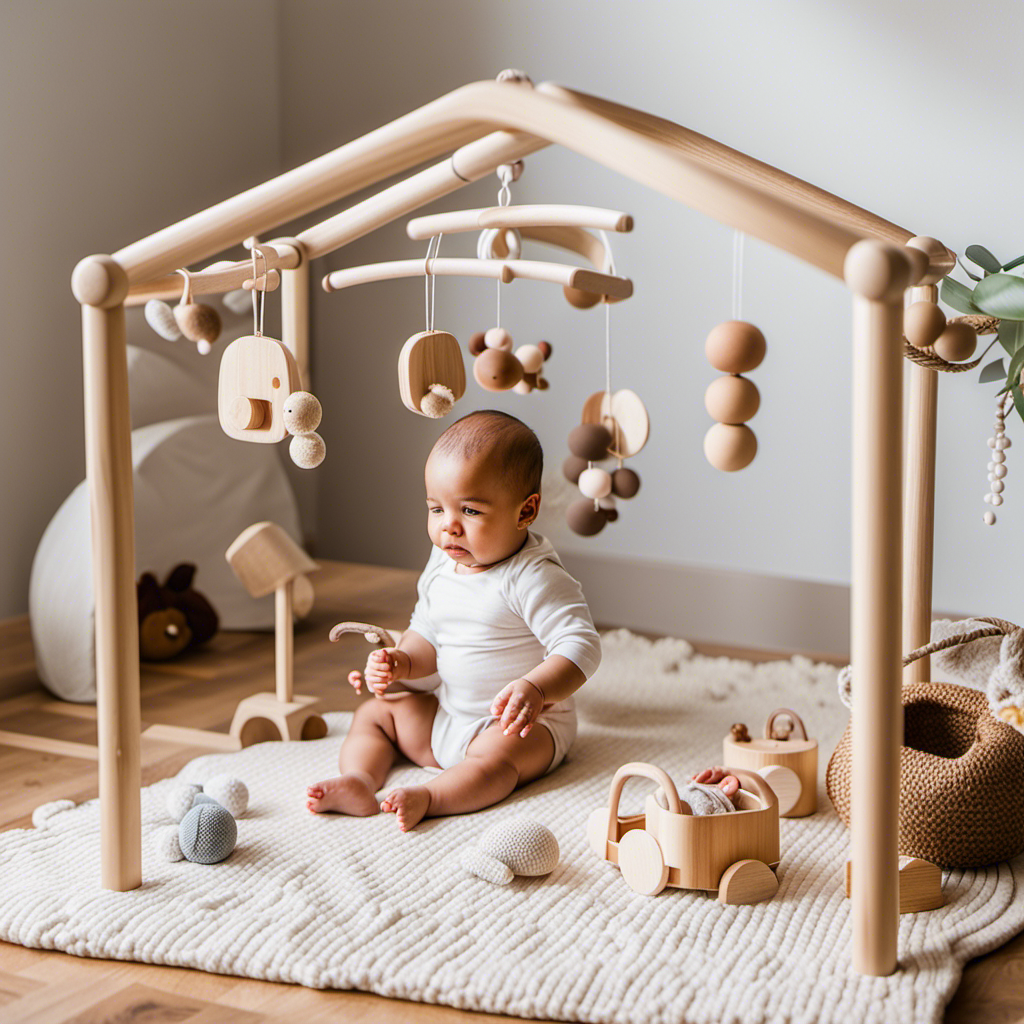
As a parent, I understand the importance of choosing the best toys for my baby. Do you know that selecting the right toys can have a big impact on a child’s development?
That’s why I am excited to share with you the ultimate toy selection for newborns – Montessori toys. In this article, we will explore the key principles of Montessori toy selection, age-appropriate toys for newborns, and the benefits these toys have on their development.
Get ready to create a Montessori-inspired toy environment that will nurture your newborn’s growth and learning.
Key Takeaways
- Montessori toys have a significant impact on a baby’s development, fostering cognitive, physical, and emotional growth.
- Montessori toys are designed to cater to a newborn’s developmental needs, stimulating their senses, encouraging exploration, and promoting independent play.
- Montessori toys are made from natural materials with different textures, which allows for sensory exploration and helps develop hand-eye coordination and grasping skills.
- Creating a Montessori-inspired toy environment for newborns can lay a solid foundation for future learning and development, promoting independence, problem-solving skills, and fine motor skills.
The Importance of Montessori Toys for Newborns
The Importance of Montessori Toys for Newborns cannot be overstated. Montessori toy benefits are numerous and have a significant impact on a baby’s development.
These toys are specifically designed to stimulate their senses, encourage exploration, and promote independent play. Montessori toys are carefully crafted to cater to a newborn’s developmental needs, providing them with the right level of challenge and engagement.
By incorporating Montessori toys into a baby’s playtime, parents can foster their cognitive, physical, and emotional growth from an early age.
Montessori toy selection is crucial in ensuring that the toys align with the child’s age, abilities, and interests. It is essential to choose toys that are safe, durable, and made from natural materials. Additionally, selecting toys that promote open-ended play and allow for creativity is key.
Transitioning into the subsequent section, understanding the key principles of Montessori toy selection will help parents make informed choices for their newborns.
Key Principles of Montessori Toy Selection
One important principle of Montessori toy selection is to choose toys that foster independence and promote self-directed learning.
When selecting toys for newborns, it is important to consider the materials used and the level of sensory stimulation they provide. Montessori toys are typically made from natural materials such as wood, fabric, or metal, which are safe for babies to explore and manipulate. These materials also provide different textures and weights, stimulating their sense of touch and helping to develop their fine motor skills.
Sensory stimulation is crucial for newborns as it helps them make sense of the world around them and promotes brain development. By providing age-appropriate Montessori toys, we can support their natural curiosity and encourage their independence from an early age.
Age-Appropriate Montessori Toys for Newborns
When choosing Montessori toys for your newborn, consider the materials used and the level of sensory stimulation they provide. Montessori toys are designed to engage and stimulate your baby’s senses, promoting their overall development.
Here are four age-appropriate Montessori toys that can provide sensory stimulation and help develop fine motor skills:
-
Montessori Mobiles: These visually stimulating mobiles are designed to capture your baby’s attention and encourage visual tracking.
-
Grasping Toys: Simple wooden or fabric toys that are easy to grasp can help your baby develop their fine motor skills and hand-eye coordination.
-
Sensory Balls: Soft, textured balls with various textures and colors can provide tactile stimulation and encourage your baby to explore and manipulate objects.
-
Rattles: Montessori rattles made from natural materials like wood or metal can provide auditory stimulation and help your baby develop their grip and coordination.
By selecting toys that offer sensory stimulation and promote fine motor skills, you are setting a strong foundation for your baby’s development.
Now, let’s delve into the benefits of Montessori toys for newborn development.
Montessori Toy Benefits for Newborn Development
Choosing Montessori toys for your newborn can have numerous benefits for their development. These toys are specifically designed to engage and challenge infants in a way that promotes their overall growth. Montessori toys are often made from natural materials like wood or fabric, which provide different textures for babies to explore through touch. They also encourage hand-eye coordination and grasping skills through the use of simple shapes and objects.
By incorporating Montessori toys into your newborn’s playtime, you can help them develop their senses and strengthen their fine motor skills. This lays a solid foundation for their future learning and development.
Now, let’s explore how to create a Montessori-inspired toy environment for your little one.
How to Create a Montessori-inspired Toy Environment for Newborns
To create a Montessori-inspired toy environment for your little one, start by organizing toys in low, accessible shelves or baskets. This allows your newborn to easily see and reach for the toys, promoting independence and exploration.
Montessori toys are designed to stimulate your baby’s senses and encourage cognitive development. Opt for toys that are made from natural materials such as wood or fabric, as they are safe and provide a sensory experience. Mobiles and rattles are great choices as they help babies develop their hand-eye coordination and auditory skills.
Additionally, consider introducing toys that promote problem-solving and fine motor skills, such as stackable blocks or shape sorters.
Frequently Asked Questions
What Are Some Common Misconceptions About Montessori Toys for Newborns?
Misconceptions about Montessori toys for newborns include the belief that they are unnecessary or too advanced. In reality, these toys offer numerous benefits, such as promoting sensory development and fostering independent play.
How Can Montessori Toys for Newborns Promote Cognitive Development?
How can Montessori toys for newborns promote cognitive development? Do they have any impact on their learning abilities? The benefits of Montessori toys lie in their ability to stimulate and engage a newborn’s senses, fostering cognitive growth from an early age.
Are There Any Specific Safety Guidelines to Consider When Choosing Montessori Toys for Newborns?
When selecting Montessori toys for newborns, it is important to consider safety guidelines. These toys should be free of small parts, made from non-toxic materials, and have no sharp edges to ensure the baby’s well-being.
Can Montessori Toys for Newborns Help With Sensory Development?
As a parent, I’ve found that Montessori toys for newborns are a great way to foster sensory development. These toys encourage sensory exploration and help develop fine motor skills in a safe and engaging way.
Are There Any Recommended Resources or Books for Further Understanding Montessori Toys for Newborns?
I recommend checking out some great resources and books to gain a deeper understanding of Montessori toys for newborns. They provide valuable insights and guidance on how to select and use these toys effectively.
Conclusion
In conclusion, Montessori toys are the ultimate choice for newborns due to their focus on promoting independent learning and development. By selecting age-appropriate toys that align with Montessori principles, parents can create a stimulating and engaging environment for their little ones.
These toys not only entertain but also enhance various skills such as sensory exploration, fine motor development, and problem-solving abilities.
So, let’s embark on this exciting journey of Montessori-inspired toy selection and watch our babies thrive like never before. It’s like unlocking a treasure trove of infinite possibilities!
Tina is the heart and soul behind Toddler Ride On Toys. With a passion for early childhood education and a deep understanding of child development, Tina ensures that every piece of content on our website reflects our commitment to playful learning. Her expertise in Montessori, Preschool, STEM, and Waldorf education philosophies helps shape our website into a valuable resource for parents, caregivers, and educators.
-

 Preschool Toys2 months ago
Preschool Toys2 months agoTop 8 Interactive Role-Play Toys for Preschoolers Reviewed
-

 Child Development3 months ago
Child Development3 months agoWhat Do You Do in Child Development Class in High School
-

 Child Development3 months ago
Child Development3 months agoWhat Is a Theory in Child Development
-

 Waldorf Toys3 months ago
Waldorf Toys3 months agoTwos and Toys: Waldorf Selections Perfect for Two-Year-Olds
-

 Child Development3 months ago
Child Development3 months agoHow Parenting Styles Affect Child Development
-

 Child Development3 months ago
Child Development3 months agoThe Science Behind How Parents Affect Child Development
-

 Child Development3 months ago
Child Development3 months agoHow Does Piaget’s Theory Impact Child Development
-
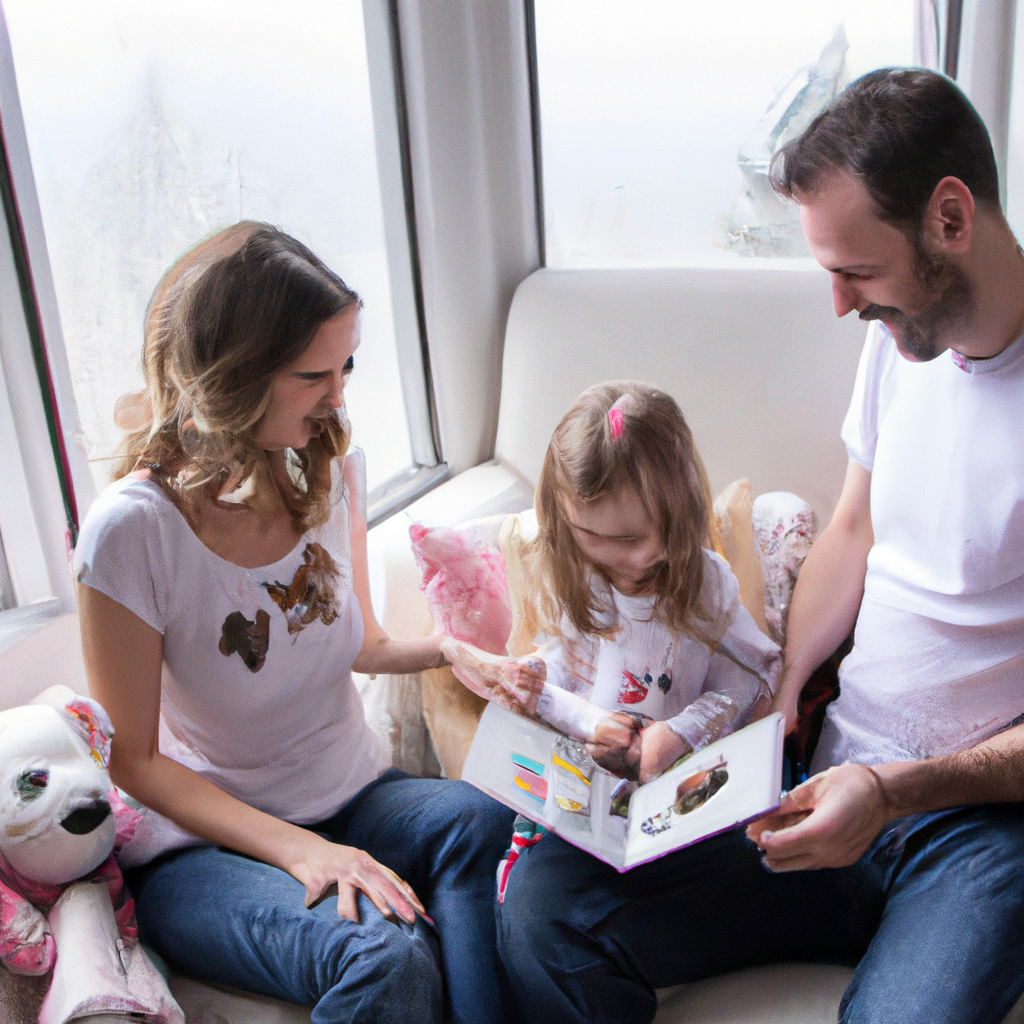
 Child Development3 months ago
Child Development3 months agoWhat Are Protective Factors in Child Development








